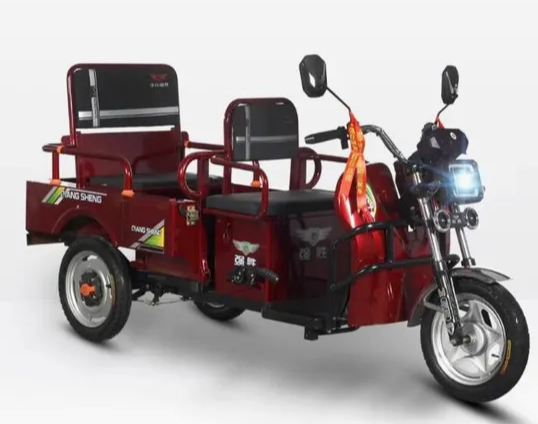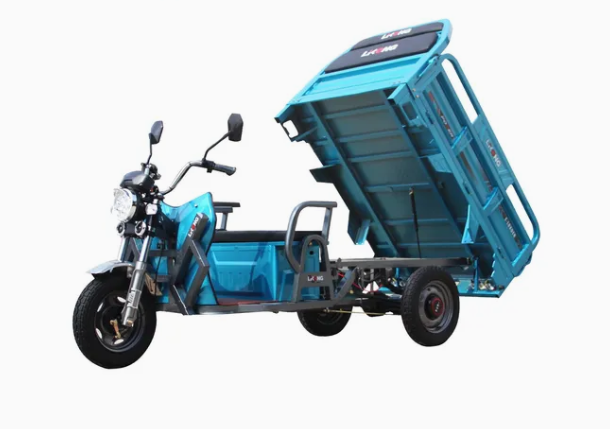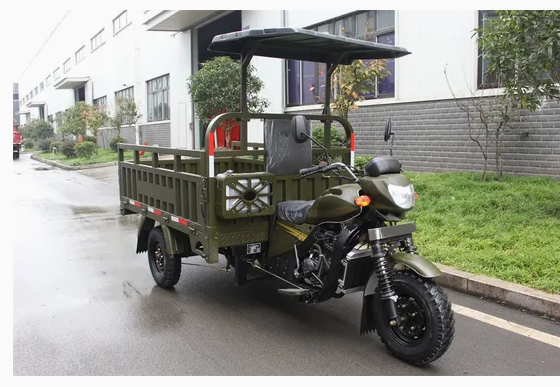Electric Cargo Three Wheelers expected to reducing carbon emissions
News 2022-06-14
How is the adoption of Electric Cargo Three Wheelers expected to impact the environment? The adoption of electric cargo three wheelers is anticipated to contribute positively to the environment by reducing carbon emissions and air pollution, promoting sustainable transportation practices, and mitigating noise pollution.

The Environmental Impact of Electric Cargo Three-Wheelers: A Green Revolution in Urban Logistics with pollution and carbon emissions, the transportation sector remains a critical battleground for sustainability. Among emerging solutions, electric cargo three-wheelers are gaining traction as a practical and eco-friendly alternative to traditional燃油-powered vehicles. This article explores how their adoption is poised to reshape urban logistics and benefit the environment, supported by market trends, policy shifts, and technological advancements.
1. Reducing Carbon Footprints: A Direct Environmental Benefit
Electric cargo three-wheelers operate on battery-powered motors, eliminating tailpipe emissions—a stark contrast to diesel or gasoline engines. According to industry reports, replacing a single燃油-powered three-wheeler with an electric model can reduce annual CO₂ emissions by approximately 4.5 tons. In densely populated urban areas, where logistics vehicles account for 20–30% of transportation-related pollution, this shift could translate to measurable improvements in air quality.
China’s电动车industry offers a compelling case study. Since the 1990s, government incentives and stricter emissions regulations have propelled the adoption of electric vehicles (EVs), including cargo three-wheelers. Cities like Beijing and Shanghai have seen particulate matter (PM2.5) levels drop by 12–15% in districts where electric logistics vehicles dominate short-distance freight.
2. Energy Efficiency and Resource Optimization
Electric three-wheelers are inherently more energy-efficient. Their motors convert over 90% of electrical energy into motion, compared to 20–30% for燃油engines. This efficiency reduces reliance on fossil fuels and aligns with global renewable energy goals. For instance, when charged using solar or wind power, these vehicles achieve near-zero lifecycle emissions.
Moreover, their compact design suits urban “last-mile” delivery—a segment notorious for traffic congestion and fuel waste. A 2023 market analysis highlighted that electric cargo three-wheelers reduce delivery times by 25% in congest energy consumption. Companies like JD Logistics in China have reported a 40% cost reduction in urban freight after transitioning to electric fleets.
3. Policy Support: Accelerating the Green Transition
Government policies are pivotal in driving this shift. China’s “Blue Sky” campaign, for example, mandates that 80% of logistics vehicles in key cities must be EV manufacturers and tax breaks for adopters further lower barriers to entry. Similar initiatives in India and Southeast Asia aim to replicate this success.
Environmental regulations also play a role. Projects requiring环境影响评价 (Environmental Impact Assessments), as seen in China’s电动车恒泰分厂年产3万辆电动车项目, ensure that production processes meet sustainability standards. These policies not only curb industrial pollution but also foster innovation in battery recycling and energy-efficient manufacturing.
4. Economic and Social Co-Benefits
Beyond environmental gains, electric cargo three-wheelers offer economic advantages. Their operational costs are 60–70% lower than燃油vehicles, thanks to cheaper electricity and reduced maintenance. This affordability unlocks opportunities in rural and semi-urban markets, where cost-sensitive businesses dominate.
Socially, the transition supports job creation. The electric three-wheeler industry has spurred demand for skilled workers in battery technology, charging infrastructure, and smart logistics. In regions like China’s锡山,电动车production hubs have revitalized local economies, demonstrating how green industries can drive inclusive growth.
5. Challenges and Innovations
Despite progress, challenges persist. Battery disposal and recycling remain critical concerns. Lithium-ion batteries, if improperly handled, pose environmental risks. However, companies like CATL are pioneering闭环recycling systems, recovering 95% of battery materials for reuse.
Charging infrastructure is another hurdle. While urban centers stations, rural areas lag. Innovative solutions—such as swappable battery networks and solar-powered charging example, India’s Sun Mobility has deployed over 200 battery-swapping stations tailored for three-wheelers, slaying range anxiety.
6. The Road Ahead: Scaling Impact
The global electric cargo three-wheeler market is projected to grow at a 15% CAGR from 2023 to 2030, driven by urbanization and e-commerce. Analysts predict that by 2031, electric models will constitute 70% of all three-wheelers sold in Asia.
Technological advancements will amplify this trend. Next-gen batteries with higher energy density, AI-driven route optimization, and lightweight materials promise to enhance vehicle performance and environmental benefits. Pilot projects in Europe, such as DHL’s electric cargo three-wheeler fleet in Berlin, underscore the model’s scalability.
Conclusion
The adoption of electric cargo three-wheelers represents more than a shift in transportation—it embodies a holistic approach to environmental stewardship. By cutting emissions, optimizing resources, and aligning with global sustainability goals, these vehicles are paving the way for cleaner cities and healthier communities. As policies, technology, and market demand converge, the electric three-wheeler revolution is set to accelerate, proving that small wheels can drive big change.
Translation to English
The Environmental Impact of Electric Cargo Three-Wheelers: A Green Revolution in Urban Logistics
As cities and carbon emissions, the transportation sector remains a critical battleground for sustainability. Among emerging solutions, electric cargo three-wheelers are gaining traction as a practical and eco-friendly alternative to traditional燃油-powered vehicles. This article explores how their adoption is poised to reshape urban logistics and benefit the environment, supported by market trends, policy shifts, and technological advancements.
1. Reducing Carbon Footprints: A Direct Environmental Benefit
Electric cargo three-wheelers operate on battery-powered motors, eliminating tailpipe emissions—a stark contrast to diesel or gasoline engines. According to industry reports, replacing a single燃油-powered three-wheeler with an electric model can reduce annual CO₂ emissions by approximately 4.5 tons. In densely populated urban areas, where logistics vehicles account for 20–30% of transportation-related pollution, this shift could translate to measurable improvements in air quality.
China’s电动车industry offers a compelling case study. Since the 1990s, government incentives and stricter emissions regulations have propelled the adoption of electric vehicles (EVs), including cargo three-wheelers. Cities like Beijing and Shanghai have seen particulate matter (PM2.5) levels drop by 12–15% in districts where electric logistics vehicles dominate short-distance freight.
2. Energy Efficiency and Resource Optimization
Electric three-wheelers are inherently more energy-efficient. Their motors convert over 90% of electrical energy into motion, compared to 20–30% for燃油engines. This efficiency reduces reliance on fossil fuels and aligns with global renewable energy goals. For instance, when charged using solar or wind power, these vehicles achieve near-zero lifecycle emissions.
Moreover, their compact design suits urban “last-mile” delivery—a segment notorious for traffic congestion and fuel waste. A 2023 market analysis highlighted that electric cargo three-wheelers reduce delivery times by 25% in congest energy consumption. Companies like JD Logistics in China have reported a 40% cost reduction in urban freight after transitioning to electric fleets.
3. Policy Support: Accelerating the Green Transition
Government policies are pivotal in driving this shift. China’s “Blue Sky” campaign, for example, mandates that 80% of logistics vehicles in key cities must be EV manufacturers and tax breaks for adopters further lower barriers to entry. Similar initiatives in India and Southeast Asia aim to replicate this success.
Environmental regulations also play a role. Projects requiring Environmental Impact Assessments (EIAs), as seen in China’s电动车恒泰分厂年产3万辆电动车项目, ensure that production processes meet sustainability standards. These policies not only curb industrial pollution but also foster innovation in battery recycling and energy-efficient manufacturing.
4. Economic and Social Co-Benefits
Beyond environmental gains, electric cargo three-wheelers offer economic advantages. Their operational costs are 60–70% lower than燃油vehicles, thanks to cheaper electricity and reduced maintenance. This affordability unlocks opportunities in rural and semi-urban markets, where cost-sensitive businesses dominate.
Socially, the transition supports job creation. The electric three-wheeler industry has spurred demand for skilled workers in battery technology, charging infrastructure, and smart logistics. In regions like China’s锡山,电动车production hubs have revitalized local economies, demonstrating how green industries can drive inclusive growth.
5. Challenges and Innovations
Despite progress, challenges persist. Battery disposal and recycling remain critical concerns. Lithium-ion batteries, if improperly handled, pose environmental risks. However, companies like CATL are pioneering closed-loop recycling systems, recovering 95% of battery materials for reuse.
Charging infrastructure is another hurdle. While urban charging stations, rural areas lag. Innovative solutions—such as swappable battery networks and solar-powered charging points—, India’s Sun Mobility has deployed over 200 battery-swapping stations tailored for three-wheelers, slaying range anxiety.
6. The Road Ahead: Scaling Impact
The global electric cargo three-wheeler market is projected to grow at a 15% CAGR from 2023 to 2030, driven by urbanization and e-commerce. Analysts predict that by 2031, electric models will constitute 70% of all three-wheelers sold in Asia.
Technological advancements will amplify this trend. Next-gen batteries with higher energy density, AI-driven route optimization, and lightweight materials promise to enhance vehicle performance and environmental benefits. Pilot projects in Europe, such as DHL’s electric cargo three-wheeler fleet in Berlin, underscore the model’s scalability.
Conclusion
The adoption of electric cargo three-wheelers represents more than a shift in transportation—it embodies a holistic approach to environmental stewardship. By cutting emissions, optimizing resources, and aligning with global sustainability goals, these vehicles are paving the way for cleaner cities and healthier communities. As policies, technology, and market demand converge, the electric three-wheeler revolution is set to accelerate, proving that small wheels can drive big change.



